Noëlle blanket
13.Nov.20 / Kirsten BalleringElegant flowers, a comfortable size and rainbow colours make the Noëlle blanket a must-have crochet pattern. This stunning project is designed to work with a Scheepjes Catona Colour pack, which helps you to create this fluid rainbow-gradient blanket.
The pattern is suitable for intermediate crocheters. The written instructions step you through the pattern, while clear diagrams and photo tutorials demonstrate how to put the flower motifs together.
Materials and preparation
Yarn
Rainbow
Scheepjes Catona (100% mercerized cotton), 100g/250m- Colour A: 106 Snow White x 8 balls
- All colours: x 109 balls
Shop the yarn!
You can find the Scheepjes Catona and Colour packs at Scheepjes retailers, or online at:
Crochet hook
3.5mm (US Size E/4).
Measurements
Blocked and finished blanket measures 120 x 150cm (47 x 59in).
Gauge/tension
Motif up to Round 5 measures 7cm (2.75in) across flat to flat side, 8cm (3.15in) across point to point.
Notes
- You’ll use different colours for each motif. These are indicated in the pattern as ‘Colour 1’ and ‘Colour 2’. Check out the colour layout and table for the actual colour combinations. Please note that full motifs with combination 52 and 88 are only made once, all the other twice.
- The motifs are joined together by working a joining round in Colour A around each motif and joining to adjacent motifs where necessary. So you can work all motifs up to Round 5 before joining.
Abbreviations (US terms)
- BPhdc: Back Post half double crochet: yarn over, insert hook from back to front and back to back around stem of st, yarn over, pull up loop, yarn over, pull through all loops
- ch: chain
- ch-sp: chain space(s)
- dc: double crochet
- dc2tog: double crochet 2 stitches together: (yarn over, insert hook in st/sp, yarn over, pull up loop, yarn over, pull through first 2 loops on hook) in each of the two sts/sps, yarn over, pull through all loops on hook
- dc3tog: double crochet 3 stitches together: (yarn over, insert hook in st/sp, yarn over, pull up loop, yarn over, pull through first 2 loops on hook) in each of the three sts/sps, yarn over, pull through all loops on hook
- dropped hdc: dropped half double crochet: yarn over, insert hook in the indicated sp/st, yarn over, pull up a loop to height of current st, yarn over, pull through all loops on hook
- hdc: half double crochet
- hdc2tog: half double crochet 2 stitches together: (yarn over, insert hook in st/sp), yarn over, pull up loop) in each of the two sts/sps, yarn over, pull through all loops on hook
- picot: ch2, insert hook in second ch from hook, yarn over, pull up loop and immediately pull through loops on hook
- RS: Right side
- sc: single crochet
- sp(s): space(s)
- ss: slip sstitch
- st(s): stitch(es)
- tr: treble crochet
- WS: wrong side
Repeat formats
- *….; rep from * once/twice/3x Crochet the instructions after * and then repeat that section a further number of times as indicated.
- (…) once/twice/3x Crochet the instructions between brackets the total number of times indicated.
- […] Indicates the amount of stitches at the end of a row or round.
- (…) in same st/sp Indicates that all instructions between brackets are worked in the same stitch or space.
Colour layout
Full motif colour combinations
You will create 182 full motifs, and 13 half motifs with the colours from your colour pack. You’ll need to make two full motifs out of each colour combination, with the exception of combination 88 and 52 where you’ll only make one full motif.
Note that the colour combinations are paired: Combination 1 and 2 are both combining the same colours, only for two motifs Colour 1 is used on the inside, and for the other combination Colour 2. So while the table lists 92 combinations, you only have 46 pairs of colours. The numbers in the table below correspond with the numbers in the colour overview.
You will not use colour 74, 105, 106, 110, 130, 157, 162, 248, 254, 257, 387, 393, 395, 404, 501, 505 and 507.
Tip: Sort out your combinations at the start of the blanket and keep the balls together with a rubber band or something similar.
Combination |
Colour 1 (inside) |
Colour 2 (outside) |
1 |
524 |
263 |
2 |
263 |
524 |
3 |
264 |
256 |
4 |
256 |
264 |
5 |
396 |
517 |
6 |
517 |
396 |
7 |
516 |
115 |
8 |
115 |
516 |
9 |
281 |
386 |
10 |
386 |
281 |
11 |
258 |
192 |
12 |
192 |
258 |
13 |
255 |
414 |
14 |
414 |
255 |
15 |
410 |
189 |
16 |
189 |
410 |
17 |
252 |
390 |
18 |
390 |
252 |
19 |
388 |
504 |
20 |
504 |
388 |
21 |
522 |
249 |
22 |
249 |
522 |
23 |
101 |
179 |
24 |
179 |
101 |
25 |
403 |
100 |
26 |
100 |
403 |
27 |
208 |
280 |
28 |
280 |
208 |
29 |
411 |
383 |
30 |
383 |
411 |
31 |
528 |
244 |
32 |
244 |
528 |
33 |
212 |
525 |
34 |
525 |
212 |
35 |
261 |
124 |
36 |
124 |
261 |
37 |
245 |
205 |
38 |
205 |
245 |
39 |
513 |
515 |
40 |
515 |
513 |
41 |
253 |
241 |
42 |
241 |
253 |
43 |
512 |
392 |
44 |
392 |
512 |
45 |
389 |
412 |
46 |
412 |
389 |
47 |
385 |
514 |
48 |
514 |
385 |
49 |
402 |
391 |
50 |
391 |
402 |
51 |
172 |
242 |
52 (only 1) |
242 |
172 |
53 |
400 |
146 |
54 |
146 |
400 |
55 |
509 |
510 |
56 |
510 |
509 |
57 |
397 |
401 |
58 |
401 |
397 |
59 |
247 |
399 |
60 |
399 |
247 |
61 |
511 |
201 |
62 |
201 |
511 |
63 |
384 |
173 |
64 |
173 |
384 |
65 |
527 |
164 |
66 |
164 |
527 |
67 |
113 |
508 |
68 |
508 |
113 |
69 |
520 |
521 |
70 |
521 |
520 |
71 |
240 |
526 |
72 |
526 |
240 |
73 |
398 |
128 |
74 |
128 |
398 |
75 |
251 |
394 |
76 |
394 |
251 |
77 |
226 |
282 |
78 |
282 |
226 |
79 |
246 |
519 |
80 |
519 |
246 |
81 |
409 |
413 |
82 |
413 |
409 |
83 |
518 |
114 |
84 |
114 |
518 |
85 |
238 |
222 |
86 |
222 |
238 |
87 |
408 |
523 |
88 (only 1) |
523 |
408 |
89 |
502 |
503 |
90 |
503 |
502 |
91 |
406 |
506 |
92 |
506 |
406 |
Half motif colour combinations
Make 1 half motif each with combination 19, 21, 23, 26, 28, 30, 34, 37, 41, 44, 50, 52 and 90. If you don’t have enough yarn leftovers for these combinations, pick similar colours that are not used in adjacent motifs.
Colour Layout
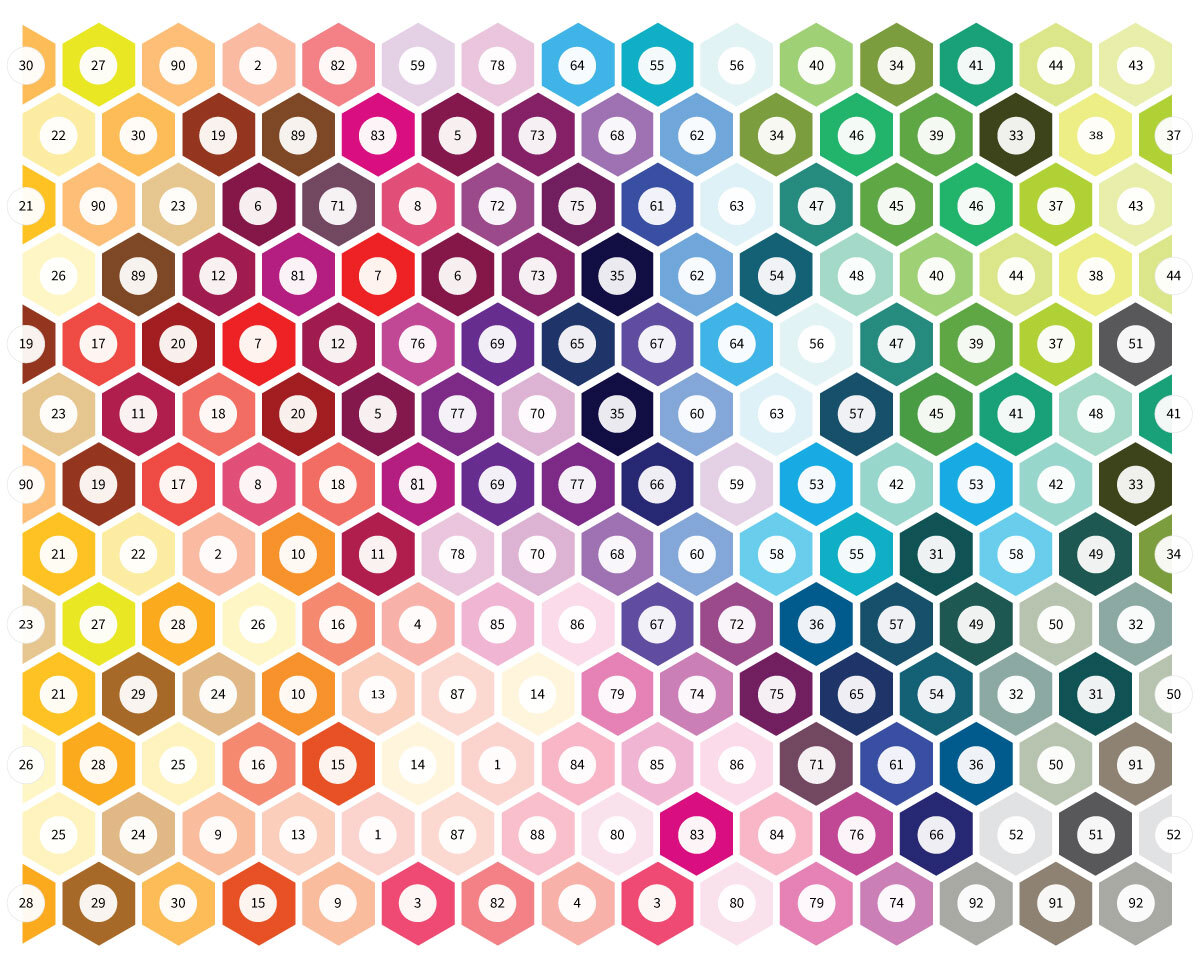
Techniques
Trebles in picots
Please note: a different colour to show the joining is used for contrast in the photos.
When you’re working the joining around your first motif and joining rounds of subsequent motifs, you’ll be making tr’s in the picots below. When you make a tr (photo 1), yarn over twice and insert your hook into both chains of the picot. Yarn over again, pull up a loop, and (yarn over, pull through two loops) three times until you’ve made the tr (photo 2). Next, work a dc in the stitch behind the tr (photo 3). Ch2, work a dc in the first st on the other side of the chain. Next, make a tr as you did before in the same picot (photo 4). This is how you create a ‘V’ of trebles in each corner. Work your way around the motif as instructed. Once fastened off, your motifs look like in photo 5.
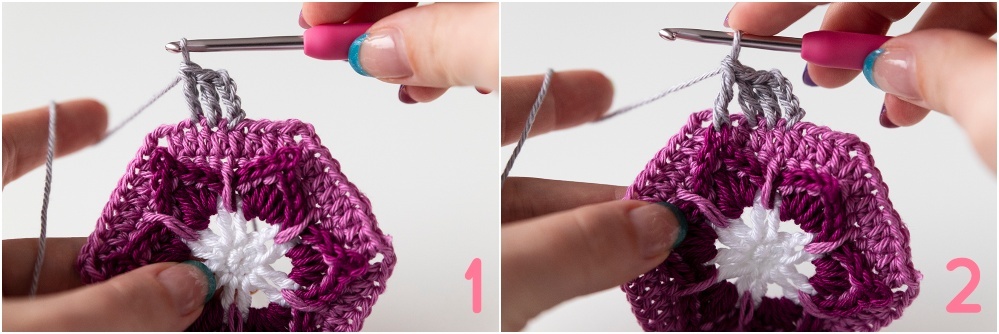
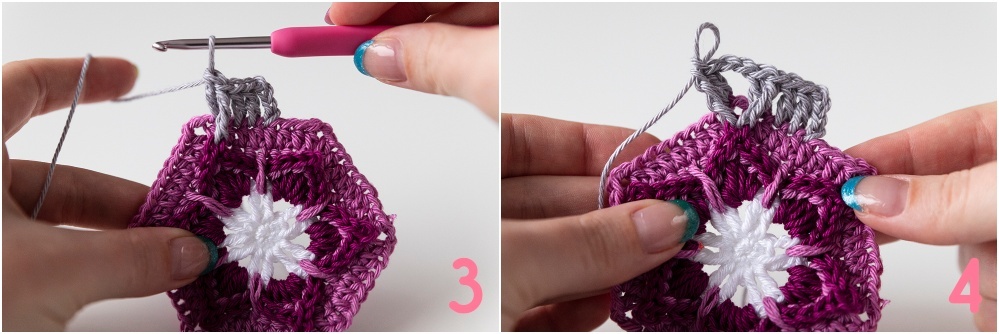
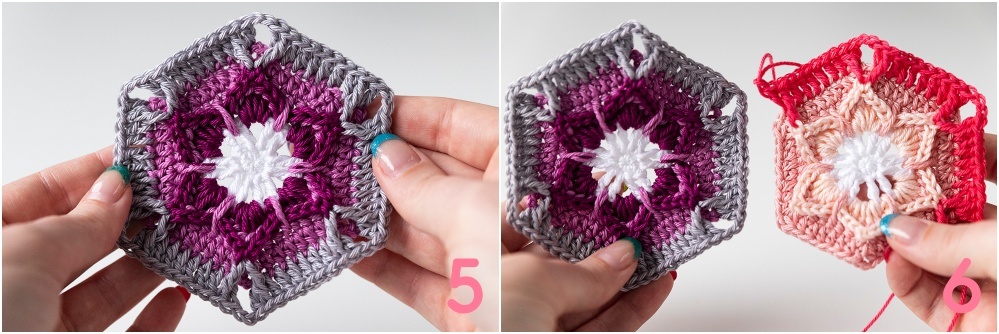
Joining motifs
The joining rounds for other motifs are very similar to the first round, with one significant difference: to achieve a flexible join we’ll be taking up loops from the other motif before we work a stitch. You do this with the WS’s of both motifs together.
Note: To show the join I’ve worked with two different colours of yarn. This might look slightly messy in the tutorial, but remember that in the blanket you’ll be working with one colour.
When you reach a side that you will join to other motifs (photo 6), crochet up until the first chain space of the side that’s to be joined. Ch1, 1ss in the chain space of the other motif (photo 7). Ch1, remove your hook from the (red) loop. Now insert your hook from back to front through the back loop of the chain-spaces’ last chain of the other motif (photo 8, this is the loop on the side closest to you). Pick up the (red) loop and pull it through the back loop of the other motif (photo 9).
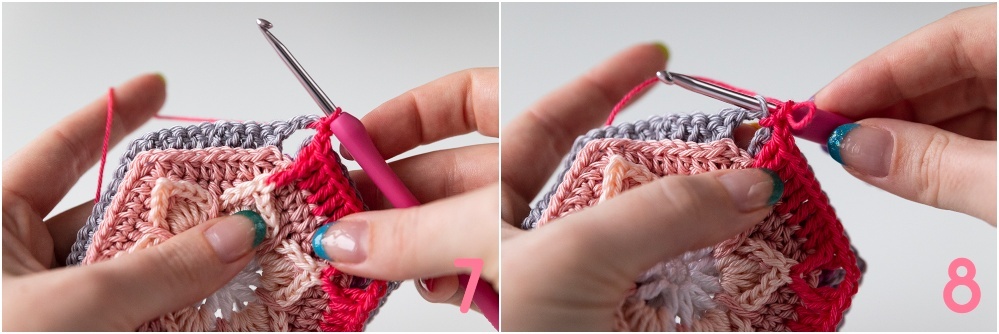
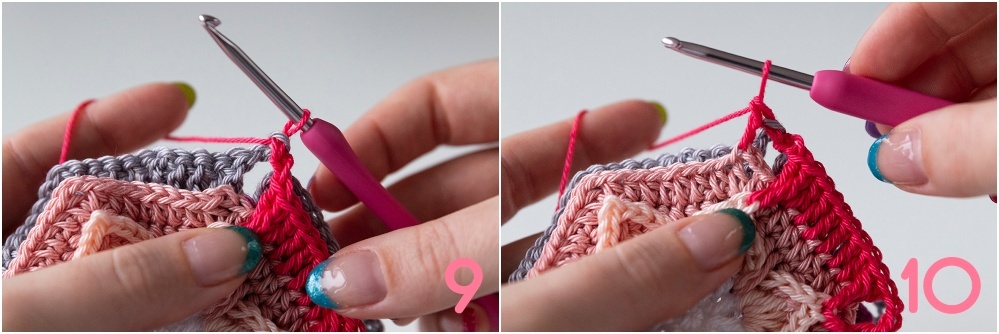
Now work your first stitch on the original motif, which is 1dc in the first stitch (photo 10). Take your hook out of the loop again, insert from back to front through the back loop of the first dc on the other motif (photo 11), pick up your (red) loop again and pull through (photo 12). You’ve now joined the first dc’s together. Next, work a tr in the picot on your motif (photo 13), take your hook out of the loop and join it to the tr on the other motif. Continue like this until you’ve joined all dc’s and tr’s on that side. Ch1 and finish with a ss in the next chain space (photo 14).
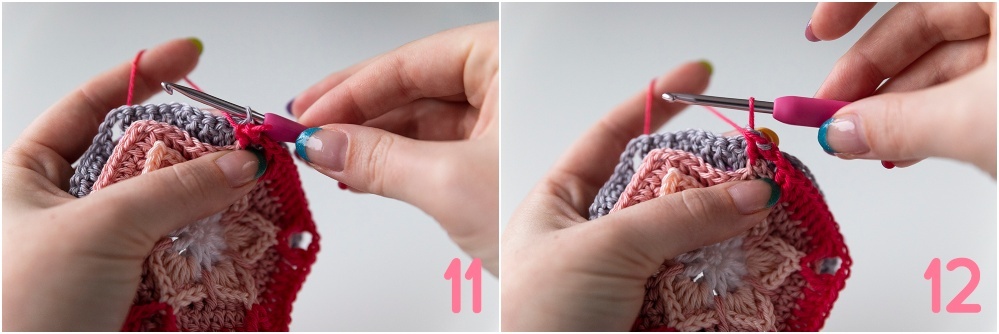
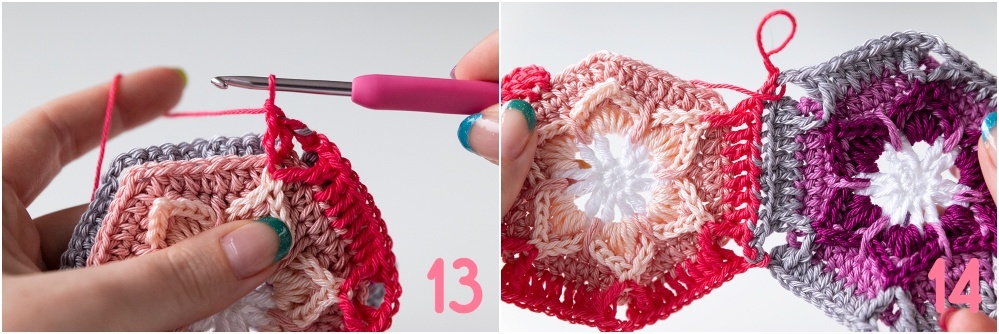
You can now continue with a ss to another motif or work a side that’s not joined to another motif. See the pattern for pattern instructions.
Crochet pattern
Full Motif (make 182)
The motifs are worked in rounds on the RS, no turning involved.
With Colour A, make a magic ring.
Round 1 (RS) 6sc in magic ring, ss in first sc, close ring by pulling thread. [6 sc]
Round 2 Ch4 (counts as first dc + ch1), 1dc in st at base of ch4, *(1dc, ch1, 1dc) in next st; repeat from * another 4 times, ss in third ch to close round, cut yarn. [12 dc, 6 ch-sps]
Round 3 Join Colour 1 with a ss in the sp between 2 dc, ch1, 1sc in same sp, *(3dc, picot, 3dc) in next ch-1 sp, 1sc in next sp between 2 dc; repeat from * another 4 times, (3dc, picot, 3dc) in next ch-1 sp, ss in first sc, cut yarn. [36 dc, 6 picots, 6 sc]
Round 4 Join Colour 2 with a ss around the stem of st before a sc, ch2 (doesn’t count as st), 1BPhdc in same st, 1 dropped hdc in sp between 2 dc in Round 2 (dropped hdc sits over sc of previous round), *1BPhdc around each of next 6 sts skipping picot, 1 dropped hdc in sp between 2 dc of Round 2; repeat from * another 4 times, 1BPhdc around each of next 5 sts skipping picot, ss in first BPhdc, don’t cut yarn. [36 BPhdc, 6 dropped hdc]
Round 5 Ch2 (doesn’t count as st), 1hdc in st at base of ch2, 4hdc, (1hdc, ch2, 1hdc) in next st, *6hdc, (1hdc, ch2, 1hdc) in next st; repeat from * another 4 times, 1hdc, ss in first hdc, cut yarn. [48 hdc, 6 ch-sps]
Weave in all ends. You can crochet over the ends of Round 1, 3 and 5 as you go if you don’t want to weave in all the ends separately.
Half Motif (make 13)
The half motif will be worked in rows. You will turn in the first row. All other rows are worked from the RS without turning. See Diagram 2: Half Motif for extra clarification.
With Colour A, make a magic ring.
Row 1 (WS) Ch1, 4sc in ring, don’t close ring as for whole motif but turn work, pull ring tight. [4 sc]
Row 2 (RS) Ch4 (counts as first dc + ch1), 1dc in sc at base of ch4, (1dc, ch1, 1dc) 3 times, cut yarn. [8 dc, 4 ch]
Row 3 (RS) Join Colour 1 with ss in the first ch-sp, (ch3, picot, 3dc) in ch-sp, *1sc between 2 dc from previous row, (3dc, picot, 3dc) in next ch-sp; repeat from * another time, 1sc between 2 dc from previous row, (3dc, picot, 1dc) in final ch-sp, cut yarn. [20 dc, 4 picots, 3 sc]
Row 4 (RS) Join Colour 2 with a ss in first ch-sp (right of picot, so it will look like you’re making a BPhdc around the ch3), ch2 (counts as first BPhdc), skip picot, 1BPhdc around each of next 3 dc’s, 1 dropped hdc in sp between 2 dc of Row 2 (dropped hdc sits over sc of previous row), *1BPhdc around each of next 6 sts skipping picot, 1 dropped hdc in sp between 2 dc of Row 2; repeat from * another time, 1BPhdc around each of next 4 sts skipping picot, cut yarn. [20 BPhdc, 3 dropped hdc]
Row 5 (RS) Join Colour 2 again with a ss in second ch from beg-ch of previous row, ch3 (counts as first hdc + ch1), skip ch-2 sp, 1hdc in next st, 6hdc, *(1hdc, ch2, 1hdc) in next st, 6hdc; repeat from * another time, (1hdc, ch2, 1hdc) in final st, cut yarn. [26 hdc, 4 ch-2 corners]
Weave in all ends.
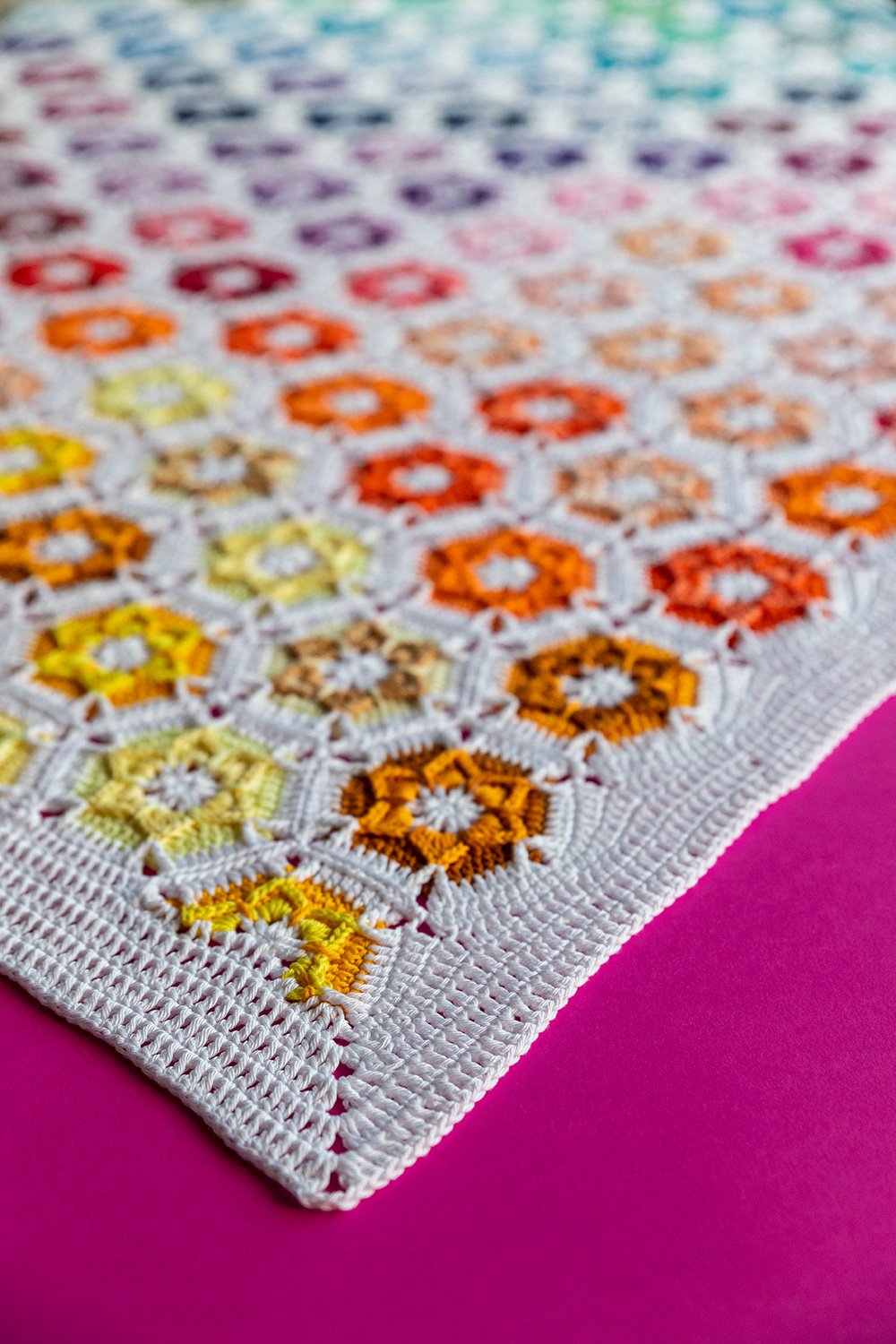
Joining
You’ll now be joining the motifs as you go with a dc-border in Colour A around each motif. We’ll join with a flat join. This is done as follows: remove your hook from the loop on your current motif, insert hook in the stitch on the other motif from front to back, pick up the loop again and pull through the stitch, effectively slip stitching the stitches together.
This method gives you a flat and delicate finish. It is a little time-consuming. If you’d rather make a quick join, simply crochet the motifs together with ss’s in each motif corner.
You’ll first be joining all full motifs. Once the blanket is assembled, you’ll add the half motifs.
First motif
You’ll make a border around the first motif without joining. See Diagram 3: Joining first motif.
Note: you’ll be making two tr’s in each picot on the motif, one on each side of each corner space. If you work these tr’s in the picot, do not skip a st on the motif, but crochet your next st in the st behind the tr. This is how we increase sts in the Edge Round without crocheting in the corners themselves.
Edge Round (RS) Join Colour A with a ss in fifth st of any side (this is the st right above a dropped hdc), ch3 (doesn’t count as st), 1dc in st at base of ch3, 2dc, *1tr in picot of Round 3, 1dc in final st of side, ch2, skip ch-2 sp, 1dc in first st of next side, 1tr in same picot of Round 3, 6dc; repeat from * another 4 times, 1tr in next picot of Round 3, 1dc, ch2, skip ch-2 sp, 1dc, 1tr in same picot of Round 3, 3dc, ss in first dc. Cut yarn. [48 dc, 12 tr, 6 ch-2 sps]
Joining other motifs
I joined the length of the blanket first and as such, crocheted 14 motifs together to form the first row. Then I joined the motifs from the next row one by one to the first row, and so on for all other rows.
Read the instructions below carefully. It looks complicated, but once you get the rhythm of the join it will become easier. See the photo tutorial for visual instructions.
Joining Round (RS) Join Colour A with ss in fifth st of any side (right above a dropped hdc), ch3 (doesn’t count as st), 1dc in st at base of ch3, 2dc, 1tr in picot of Round 3, 1dc in final st, *ch2, skip ch-2 sp, 1dc in first st at other side, 1tr in same picot of Round 3, 6dc, 1tr in next picot of Round 3, 1dc in final st; repeat from * until you reach a side that needs to be joined. Continue as follows:
**ch1, 1ss in ch-sp of other motif(s), ch1, join to next st on other motif as follows: remove hook from loop, insert hook from back to front through BL of last ch on other motif, pick up loop and pull through loop on hook. 1dc in first st on motif, join to BL of next st on other motif as described before, 1tr in picot of Round 3, join to BL of next st on other motif, (1dc, join to BL of next st on other motif) 6 times, 1tr in picot of Round 3, join to BL of next st on other motif, 1dc, join to BL of next st on other motif; repeat from ** for all sides that need to be joined. If you join three motifs in one corner, make a ss in each corner before continuing to the next side.
Once you reach a side that doesn’t need to be joined, either repeat from * to ; or, if you’ve reached your first side again, ch1, 1ss, ch1, skip ch-2 sp, 1dc in first st, 1tr in picot of Round 3, 3dc, join with ss in first st. Cut yarn. [48 dc, 12 tr, 6 ch-2 sps per motif]
Joining troubleshooting
- The tr’s don’t line up. chances are that you either forgot to pick up a stitch by removing your hook from the loop, or you’ve accidentally skipped a st (this happens often at the side with the Round 4 join). The only thing to do here is ripping that side out and redo.
- One side of the motif has more stitches than the other. This happens occasionally, and usually, it means that you’ve crocheted sts in the corner space of Round 3 or 4 of the motif. You can either redo the motif, or smuggle a little bit in Round 5 by crocheting sts together on the short side and working multiple sts in one st on the long side.
Joining the half motifs
The half motifs are joined over their short sides to other motifs. Please note that the instructions for the left upper corner and left bottom corner half motifs differ from the general instructions. They’re specified below.
Joining Round (RS) Join Colour A with a ss in the most right ch-sp, ch3 (counts as first dc + ch1), ss in ch-sp of other motif, join sides as for full motif. When you’ve worked the ss in the final corner ch1, 1dc in final st. Cut yarn.
Left upper corner half motif (colour combo 30)
Note: The final side of this motif does not have an adjacent motif.
Joining Round (RS) Join Colour A with a ss in the most right ch-sp, ch3 (counts as first dc + ch1), ss in ch-sp of other motif, join sides as for full motif. When you’ve worked the ss in the final corner, ch1, 1dc in next side, 1tr in picot, do not skip a st, 6dc, 1tr in picot, do not skip a st, 1dc in final st on side, ch1, 1dc in final st. Cut yarn.
Left bottom corner half motif (colour combo 28)
Note: The first side of this motif does not have an adjacent motif.
Joining Round (RS) Join Colour A with a ss in the most right ch-sp, ch3 (counts as first dc + ch1), 1dc, 1tr in picot, do not skip a st, 6dc, 1tr in next picot, do not skip a st, 1dc in final st on side, ch1, ss in other ch-sp, continue joining as for other half motifs. Cut yarn.
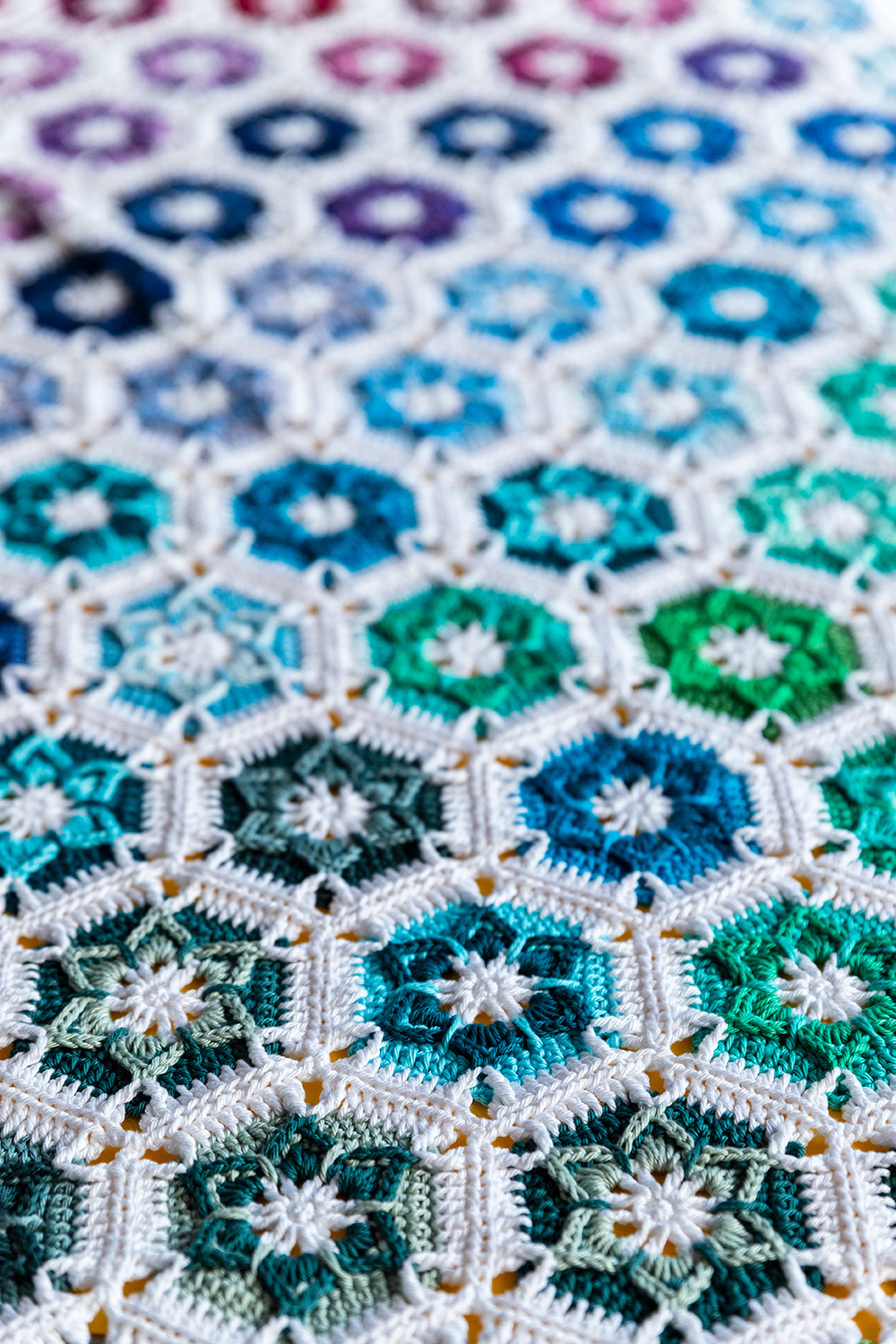
Edge
The first couple of rounds are a mixture of different stitches with different heights. This is so we can fill up the gaps on the long sides of the blanket. It might look complicated, but once you get into the rhythm of the stitches it will make sense. Have a look at Diagram 4: Edge R1-R3 for some visual help.
Round 1 (RS) Join Colour A with a ss in the left upper corner (orange/brown half motif), ch3 (counts as first dc), *14dc divided evenly over long side half motif, dc3tog in ch-sp half motif, ss-join and ch-sp next full motif, 10dc, dc3tog in ch-sp full motif, ss-join and ch-sp next half motif; repeat from * another 5 times, 14dc in long side half motif, 1dc in final ch-sp, ch3, rotate blanket 90 degrees.
1sc in corner-sp, *2sc, 3hdc, 3dc, dc2tog in final 2 sts of last Round, skip ch-sps on both motifs, dc2tog in first 2 sts of last Round on next motif, 3dc, 3hdc, 2sc, 1sc in ch-sp; repeat from * another 13 times, 2sc, 3hdc, 3dc, dc2tog in final 2 sts of last Round, 1dc in corner-sp, ch3, rotate blanket 90 degrees.
1dc in corner-sp, *10dc, dc3tog in ch-sp full motif, ss-join and ch-sp next half motif, 14dc, dc3tog in ch-sp half motif, ss-join and ch-sp next full motif; repeat from * another 5 times, 10dc, 1dc in corner-sp, ch3, rotate blanket 90 degrees.
1dc in corner-sp, dc2tog in first 2 sts of full motif, *3dc, 3hdc, 2sc, 1sc in ch-sp, 2sc, 3hdc, 3dc, dc2tog in final 2 sts of last Round, skip ch-sps on both motifs, dc2tog in first 2 sts of last Round on next motif; repeat from * another 13 times, 3dc, 3hdc, 2sc, 1sc in corner-sp, ch3, ss in beg-ch3, cut yarn. [first short side 172 sts, long sides 277 sts, second short side 168 sts]
There’s a difference of 4 sts between both short sides, because there’s a half motif more on one side. This will remain through the edge and you won’t see this in the end result.
Round 2 (RS) Join Colour A with a ss in the left upper corner, ch3 (counts as first dc), 1dc in corner-sp, 1dc, *14dc, 2dc in dc3tog, 10dc, 2dc in dc3tog; repeat from * another 5 times, 15dc, 2dc in corner-sp, ch3, rotate blanket 90 degrees.
2hdc in corner-sp, hdc2tog in first 2 sts, *3hdc, 4dc, dc2tog in dc2tog’s, 4dc, 4hdc, hdc2tog; repeat from * another 13 times, 3hdc, 4dc, dc2tog, 2dc in corner-sp, ch3, rotate blanket 90 degrees.
2dc in corner-sp, 1dc, *10dc, 2dc in dc3tog, 14dc, 2dc in dc3tog; repeat from * another 5 times, 11dc, 2dc in corner-sp, ch3, rotate blanket 90 degrees.
2dc in corner-sp, dc2tog in first st and dc2tog, *4dc, 4hdc, hdc2tog, 3hdc, 4dc, dc2tog in dc2tog; repeat from * another 13 times, 4dc, 3hdc, hdc2tog, 2hdc in corner-sp, ch3, ss in beg-ch3, cut yarn. [first short side 188 sts, long sides 251 sts, second short side 184 sts]
Round 3 (RS) Join Colour A with a ss in the left upper corner, ch3 (counts as first dc), 1dc in corner-sp, 1dc in every st to next corner-sp, (2dc, ch3, 2dc) in corner-sp, 1dc, dc2tog, *15dc, dc2tog; repeat from * another 13 times, 10dc, (2dc, ch3, 2dc) in corner-sp, 1dc in every st to corner-sp, (2dc, ch3, 2dc) in corner-sp, 10dc, *dc2tog, 15dc; repeat from * another 13 times, dc2tog, 1dc, 2dc in corner-sp, ch3, ss in beg-ch3, cut yarn. [first short side 192 sts, long sides 240 sts, second short side 188 sts]
The edge should almost lay completely flat at this point. If it instead waves, it means that you have more sts in the edge than ‘space’ available. To counter this, check where your blanket waves (this is often on the long sides, above the ch-sps of motifs), and mark with stitch markers if necessary on Round 2. Next, rip out Round 3 and decrease by crocheting either a hdc2tog or dc2tog on the indicated spaces. If need be, work extra decreases in Round 4 and 5.
Round 4 (RS) Join Colour A with a ss in the left upper corner, ch3 (counts as first dc), 1dc in corner-sp, *1dc in each st to next corner-sp, (2dc, ch3, 2dc) in corner-sp; repeat from * another 2 times, 1dc in each st to next corner-sp, (2dc, ch3) in corner-sp, ss in beg-ch3, cut yarn. [first short side 196 sts, long sides 244 sts, second short side 192 sts]
Round 5 (RS) Repeat Round 4, cut yarn. [first short side 200 sts, long sides 248 sts, second short side 196 sts]
Weave in all ends and block the blanket to size.
Adjusting the size of the blanket
You can adjust the size of the blanket by adding more motifs. I would recommend adding (or removing) in multiples of two: adding two motifs to each row (i.e. 16 motifs per row) or adding two rows to the blanket (i.e. 15 rows). This way, you will not have to adjust any instructions for the edge other than working more or less repeats from the pattern as written.
Two motifs add 19cm (7.5in) to the length of the blanket, and two rows add 20cm (8in) to the height of the blanket.
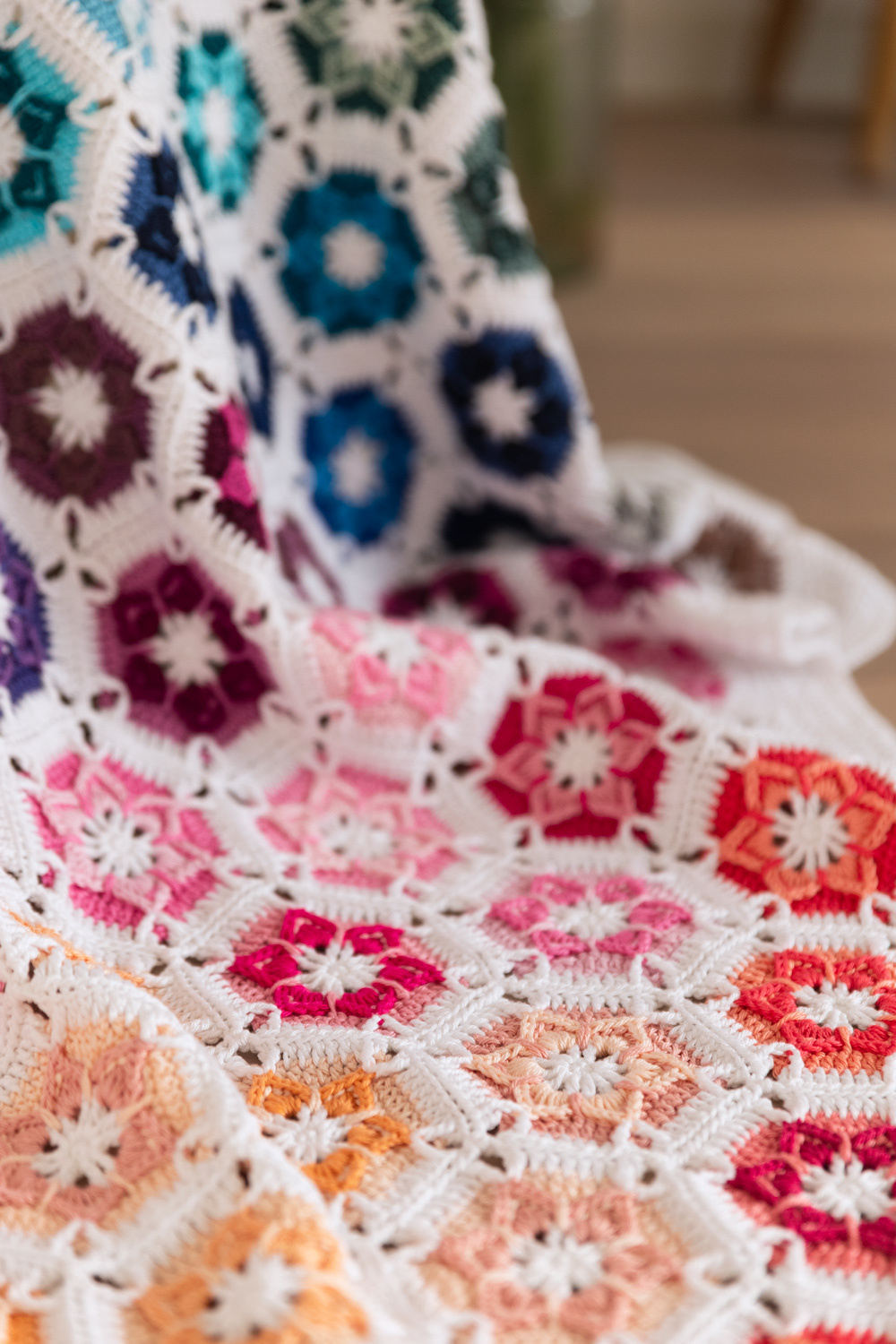
Diagram
Diagram 1: Full motif
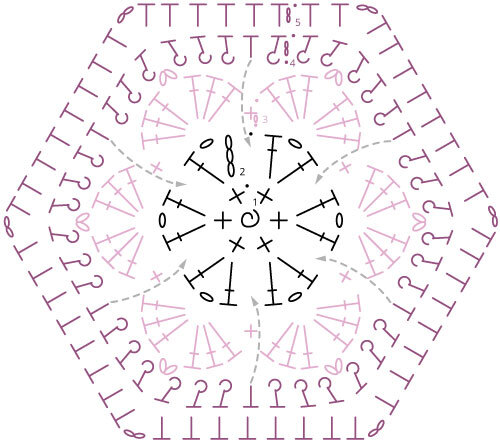
Diagram 2: Half motif
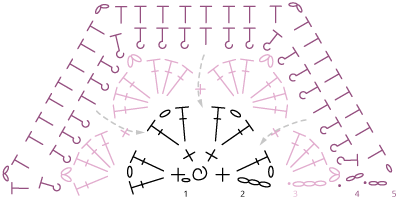
Diagram 3: Joining first motif
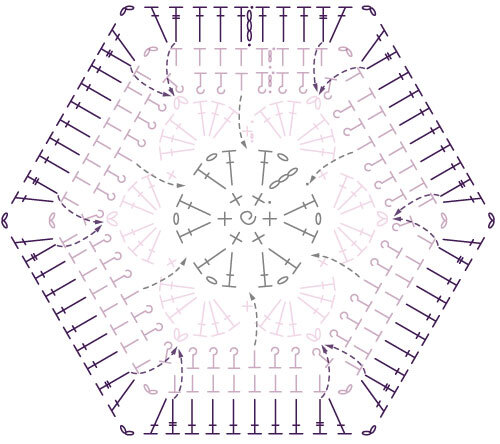
Diagram 4: Edge Rounds 1-3
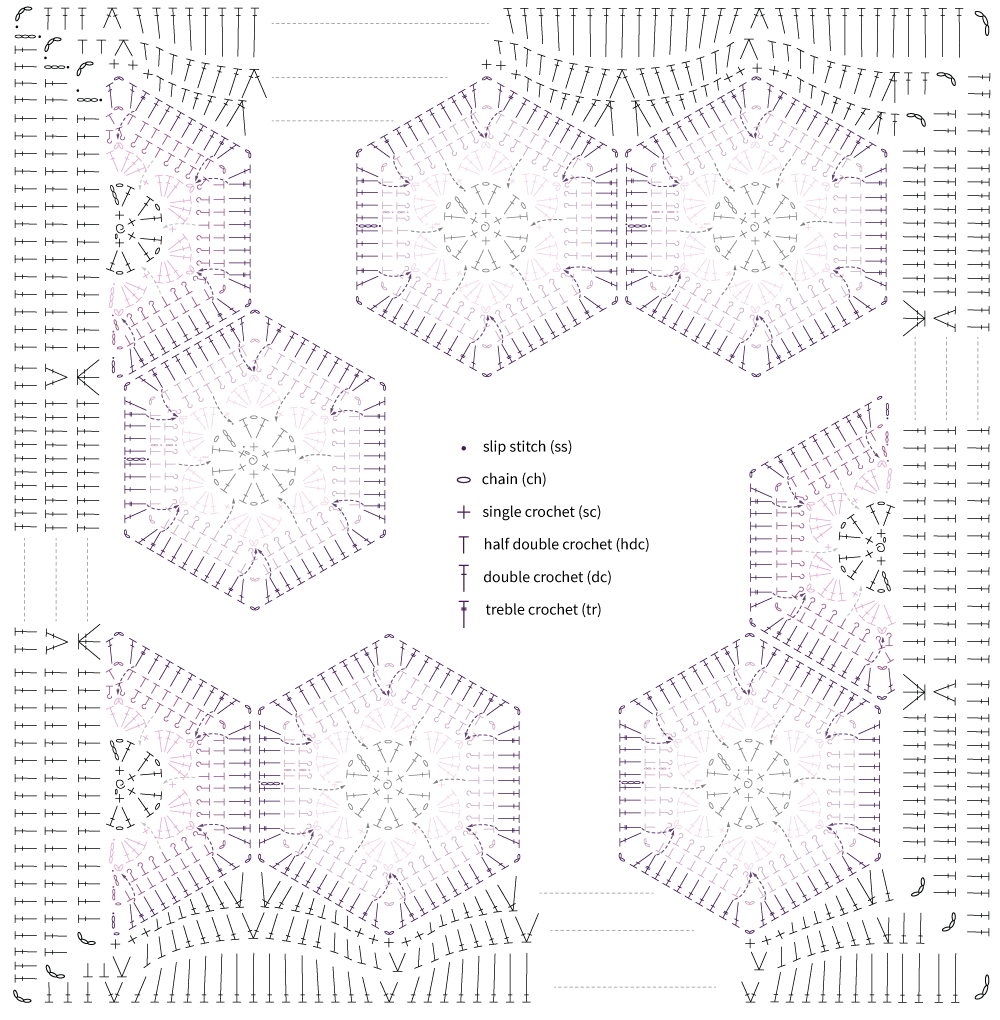
Key (US terms)
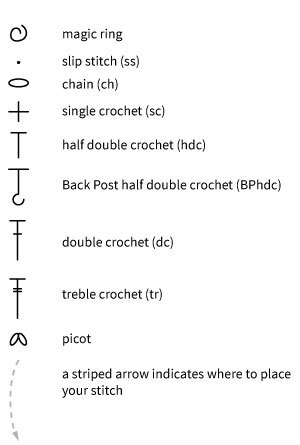





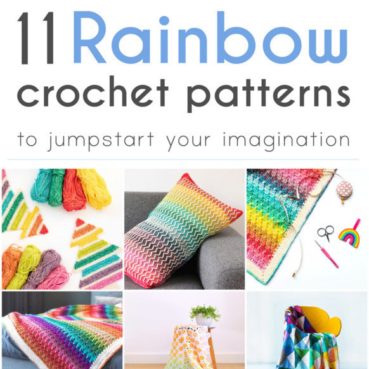
Comments
Unfortunately there are no videos for this pattern, but I do have a lot of photos to help you along :). So I hope those help! December 18, 2022 09:16 - Reply
Best wishes
Kerstin September 16, 2023 16:26 - Reply
I don't see an abbreviation 'MS' in this pattern. Could you tell me where you found it? December 19, 2023 08:34 - Reply